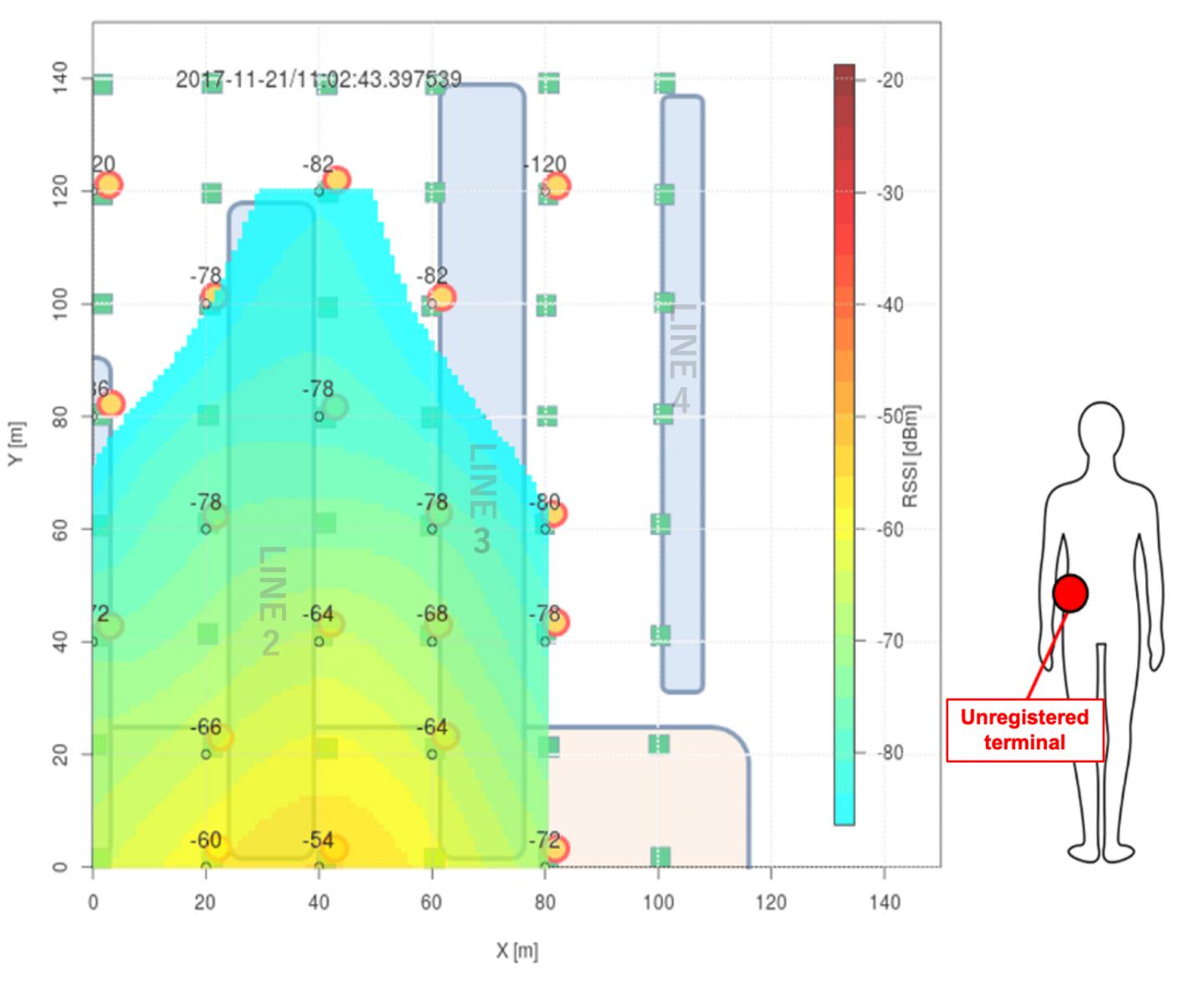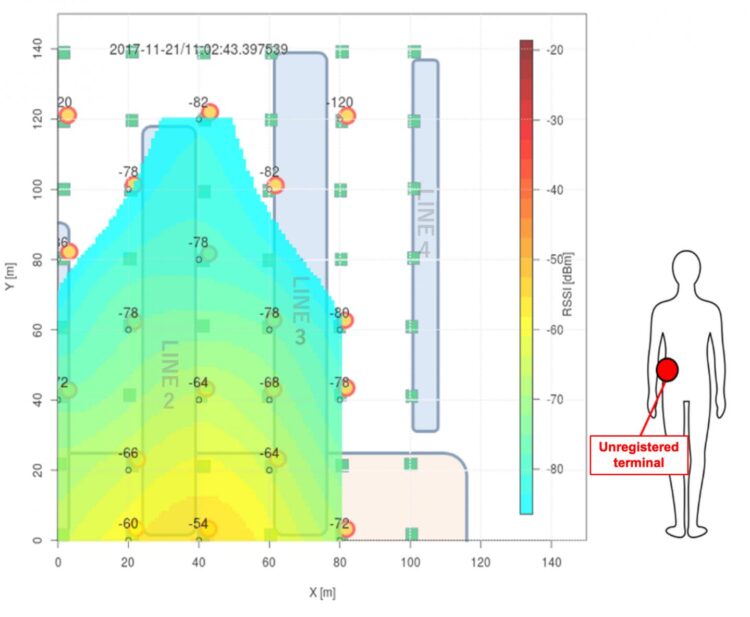Realizing a ‘non-stop line’ with wireless visualization and coordinated control of different systems

Credit: National Institute of Information and Communications Technology
[Abstract]
The National Institute of Information and Communications Technology (NICT, President: TOKUDA Hideyuki, Ph.D.) and Toyota Motor Corporation (TOYOTA) have succeeded in experimenting with stabilization technology for manufacturing systems using wireless communication, and to have realized a “non-stop line”. The “non-stop line” can be realized to detect the introduction of unregistered terminals by visualizing the radio, to suppress unplanned radio congestion, and avoiding sudden interference that occurs by coordinated control of different systems. This time, we have demonstrated these technologies at two operating TOYOTA plants.
-Test at TOYOTA Takaoka Plant: Verification of the wireless environment real-time visualization technology developed by NICT can be carried out on the actual assembly line in operation, and we confirmed that unregistered terminals can be detected before affecting the wireless system on the production line.
-Test at TOYOTA Motomachi Plant: We verified the SRF wireless platform that enables stable wireless communication through coordinated control between different wireless communication systems developed by NICT. As a result, we were able to confirm the effectiveness of this platform, such as establishing an appropriate communication route according to the degree of wireless congestion.
In the future, TOYOTA plans to gradually introduce this visualization technology to other factories in order to properly manage wireless systems at manufacturing sites. NICT will continue the demonstration experiment of this visualization technology at other TOYOTA plants, promote the research and development of the SRF wireless platform, and aim to put the stabilization technology of the wireless system to practical use at the plant.
[Background]
At manufacturing sites, the introduction of manufacturing systems using wireless communication is progressing year by year for the purpose of increasing the flexibility of production equipment in order to improve productivity, and it is expected that the number will increase further in the future. On the other hand, wireless communication technology is inseparable from personal life. At the manufacturing site, many people are working on manufacturing every day, but wireless communication associated with people such as mobile routers may unintentionally adversely affect the wireless system on the manufacturing line.
To avoid this situation, NICT and TOYOTA have been working together since 2015 to visualize the wireless environment at the manufacturing site. Figure 1 shows the result of using the sensor to visualize the range of radio waves from a terminal when a person moves around the site with a terminal that emits radio waves.
In addition, as many manufacturing systems become more wireless, there are concerns about communication instability due to interference between wireless systems and the impact on equipment operation. Since 2015, NICT has been carrying out activities of the Flexible Factory Project to promote wireless manufacturing at manufacturing sites, and by utilizing the knowledge gained through this activity, it stabilizes wireless communication by coordinated control of different types of wireless communication. We have been promoting research and development of SRF wireless platforms. In addition, in order to implement the results of research and development in society, in July 2017, we established the Flexible Factory Partner Alliance (FFPA) with companies that are highly interested in SRF wireless platforms, and have been promoting the standardization of technical specifications. Then, in September 2019, we published the technical specifications ver.1.0 for the SRF wireless platform.
[Achievements]
In this time, NICT and TOYOTA conducted a joint experiment on wireless system stabilization technology that supports the manufacturing site at two operating TOYOTA Plants, and succeeded in realizing a “non-stop line.”
The first was to verify the effectiveness of real-time visualization technology for wireless environments, and conducted a joint experiment on the assembly line in operation at the TOYOTA Takaoka Plant (see Figure 1, video is https:/
In the future, TOYOTA plans to gradually introduce this visualization technology to other factories in order to properly manage wireless systems at manufacturing sites.
The second is the verification of the function of cooperative control of heterogeneous systems in the actual environment. At the Motomachi Site of TOYOTA, we conducted an experiment of the SRF wireless platform. Since this platform performs coordinated control with other wireless systems, it constantly monitors the wireless environment and dynamically selects the appropriate wireless link and communication method. In this experiment, we generated test communication in the same frequency band as that used on the production line, and evaluated the delay of this test communication.
As a result, it was confirmed that the delay can be significantly reduced and the ratio of satisfying the delay of 100 msec or less can be improved to 100% by switching to the appropriate communication path under the control from the Field Manager (management server) (see Figure 2).
By guaranteeing a delay of 100 msec or less, more than 80% of manufacturing systems that use wireless communications can be operated stably. The results of this experiment demonstrated that the SRF wireless platform can be used to meet the required delay when a new wireless application is introduced into an actual production line.
By detecting unregistered terminals brought in by wireless visualization, unplanned wireless congestion can be suppressed, and sudden interference that still occurs can be avoided with the SRF wireless platform, “non-stop line” can be realized. By confirming the effectiveness of these technologies at the factory in operation, it is expected that stable operation of the manufacturing system using wireless communication technology will be possible at the manufacturing site where humans and machines coexist.
[Future Prospects]
In the future, NICT will gradually deploy real-time visualization technology for wireless environments to other sites of TOYOTA, and will continue demonstration experiments with the aim of putting them into practical use. In addition, regarding the SRF wireless platform, we will continue research and develop based on this experiment result, and establishment of a certification system with the aim of putting it into practical use as a platform that can utilize stable wireless communication in factories.
###
Media Contact
HIROTA Sachiko
[email protected]
Original Source
https:/





